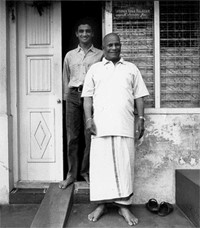Ashtanga Yoga Windsor
 Ashtanga Yoga Windsor is dedicated to teaching traditional Ashtanga Yoga.
Ashtanga Yoga Windsor is dedicated to teaching traditional Ashtanga Yoga.
Gina was Authorized during her 3rd trip to Mysore, India to Teach with blessings from Sharath Jois on August 9th 2018
What makes Ashtanga Yoga Different? …Parampara
Parampara is knowledge that is passed in succession from teacher to student. It is a Sanskrit word that denotes the principle of transmitting knowledge in its most valuable form; knowledge based on direct and practical experience. It is the basis of any lineage: the teacher and student form the links in the chain of instruction that has been passed down for thousands of years. In order for yoga instruction to be effective, true and complete, it should come from within parampara.
Knowledge can be transferred only after the student has spent many years with an experienced guru, a teacher to whom he has completely surrendered in body, mind, speech and inner being. Only then is he fit to receive knowledge. This transfer from teacher to student is parampara.
The dharma, or duty, of the student is to practice diligently and to strive to understand the teachings of the guru. The perfection of knowledge – and of yoga — lies beyond simply mastering the practice; knowledge grows from the mutual love and respect between student and teacher, a relationship that can only be cultivated over time.
 The teacher’s dharma is to teach yoga exactly as he learned it from his guru. The teaching should be presented with a good heart, with good purpose and with noble intentions. There should be an absence of harmful motivations. The teacher should not mislead the student in any way or veer from what he has been taught.
The teacher’s dharma is to teach yoga exactly as he learned it from his guru. The teaching should be presented with a good heart, with good purpose and with noble intentions. There should be an absence of harmful motivations. The teacher should not mislead the student in any way or veer from what he has been taught.
The bonding of teacher and student is a tradition reaching back many thousands of years in India, and is the foundation of a rich, spiritual heritage. The teacher can make his students steady – he can make them firm where they waver. He is like a father or mother who corrects each step in his student’s spiritual practice.
The yoga tradition exists in many ancient lineages, but today some are trying to create new ones, renouncing or altering their guru’s teachings in favor of new ways. Surrendering to parampara, however, is like entering a river of teachings that has been flowing for thousands of years, a river that age-old masters have followed into an ocean of knowledge. Even so, not all rivers reach the ocean, so one should be mindful that the tradition he or she follows is true and selfless.
Many attempt to scale the peaks in the Himalayas, but not all succeed. Through courage and surrender, however, one can scale the peaks of knowledge by the grace of the guru, who is the holder of knowledge, and who works tirelessly for his students.
Source : KPJAYI.org
NEW AND FULL MOON DAYS IN 2021
| New Moon | Full Moon |
|---|---|
| Jan 13 | Jan 28 |
| Feb 11 | Feb 27 |
| Mar 13 | Mar 28 |
| Apr 11 | Apr 26 |
| May 11 | May 26 |
| Jun 10 | Jun 24 |
| Jul 9 | Jul 23 |
| Aug 8 | Aug 22 |
| Sep 6 | Sep 20 |
| Oct 6 | Oct 20 |
| Nov 4 | Nov 19 |
| Dec 4 | Dec 18 |
* No Mysore class is held on the day of the new or full moon. TAKE REST
Class Description
Click Tabs To Learn More…
Remember!
Anyone can practice Ashtanga Yoga.
Source: Jois

